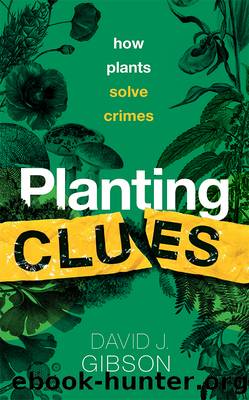Planting Clues by David J. Gibson

Author:David J. Gibson [David J. Gibson]
Language: eng
Format: epub
ISBN: 9780192639141
Publisher: OxfordUP
Published: 2022-05-27T22:05:54+00:00
6
A FORENSIC PHARMACOPOEIA
I have heard that one should die in silence. Keep quiet and be brave.
Socrates, after drinking a poisonous cup of hemlock1
After being given the death penalty in 399 bce, Socrates famously chose to drink deadly hemlock tea as his method of execution. With a brew made from as few as six to eight leaves of Conium maculatum (poison hemlock), Socrates consigned himself to a numbing death as Plato reports that his muscles became paralysed from the feet up to the heart because of the toxic effects of coniine, a plant alkaloid. Platoâs poetic account of Socratesâ death1 is likely sanitized and fictional, as typical symptoms of hemlock poisoning include vomiting, slurred speech, convulsions, and finally asphyxiation as the respiratory muscles become paralysed.2
People have used plants to poison victims since time immemorial; they have also caused accidental poisoning, and depressed individuals have used them in suicides. When a poisoning occurs, thereâs a need to identify the plant either to save the victim or to help find the perpetrator.
In this chapter, we will look at the different types of toxins from plants and fungi, and how they have caused harm to humans, accidentally and deliberately. In keeping with the rest of this book, the focus is on cases of plant poisoning that involve forensic and legal investigation at some level. These investigations involve identifying the toxin and determining culpability and blame. I will not dwell here on the methods of chemical detection of plant toxins, as these have been described in other books.3 Broadly defined, a poison is any substance that can cause death, injury, or harm, and a toxin is a poison that plants, animals, algae, viruses, bacteria, and other organisms in nature produce. Venoms are poisons that an animal delivers to the affected organism through biting (e.g. snakes) or stinging (e.g. wasps). There is some blurring of the lines between these definitions. For example, technically, we may consider the painful cocktail of chemical toxins that are injected into the skin through the hyperdermic-like trichomes on the leaves of stinging nettles (Urtica dioica) to be a venom.
The history of poisons parallels that of medicinal plants, since substances beneficial at a low dose often become poisonous at a high dose. An ancient Egyptian pharmacopoeia with more than 900 medical prescriptions contained several derived from highly poisonous plants including aconitine (from Aconitum napellus), atropine (from Atropa belladonna), opium (from Papaver somniferum), and physostigmine (from Physostigma venenosum).4
Belladonna (Atropa belladonna), also called deadly nightshade, is a good example to start with as it has beneficial properties, but has also caused accidental poisonings, and has been used by murderers.
Belladonna was used by women to enhance their beauty. During the Renaissance, Venetian women used eye drops prepared from belladonna at low doses to dilute their pupils. The very name of the plant means âbeautiful womanâ in Italian. Belladonna has also been used as a dietary supplement and alternative medicine. However, belladonna plants are extremely toxic, containing tropane alkaloids (principally atropine, chemically DL-hyoscyamine) that cause many medical problems, and can result sometimes in death.
Download
This site does not store any files on its server. We only index and link to content provided by other sites. Please contact the content providers to delete copyright contents if any and email us, we'll remove relevant links or contents immediately.
Essentials of Geology by Stephen Marshak(391)
Spectral Geometry and Inverse Scattering Theory by Huaian Diao & Hongyu Liu(282)
Probably Overthinking It: How to Use Data to Answer Questions, Avoid Statistical Traps, and Make Better Decisions by Allen B. Downey(269)
The Readable Darwin by Pechenik Jan A.;(263)
Hydrocarbon transformations in sediments from the Cathedral Hill hydrothermal vent complex at Guaymas Basin, Gulf of California ââ¬â A chemometric study of shallow seep architecture by unknow(262)
How to succeed in EPSO numerical reasoning tests by Franco Reverte José María(241)
Research and Publication Ethics by Santosh Kumar Yadav(233)
Great Ways to Learn Anatomy and Physiology by McKissock Charmaine;(232)
Mathematical Models in Economics. Lections by Shananin(232)
Quantum International Relations by James Der Derian(231)
Weathering: Types, Processes and Effects: Types, Processes and Effects by Matthew J. J. Colon(228)
Dark Matter in the Universe by John N. Bahcall(225)
Fusion of Defects by Arthur Bartels; Christopher Douglas; André Henriques(214)
Cosmic Rays by Alessandro De Angelis(211)
Mathematics Booster-1 by Singh Manoj Kumar(207)
The Structure of Scientific Inference by Mary B. Hesse(206)
Sampling by Lohr Sharon L.;(205)
Pearls from a Lost City: The LVOV School of Mathematics (History of Mathematics) (History of Mathematics, 40) by Roman Duda(202)
Flora Unveiled by Taiz Lincoln;Taiz Lee;(190)
